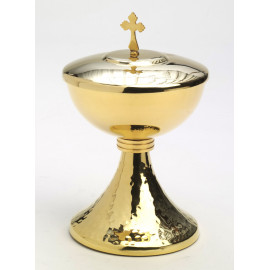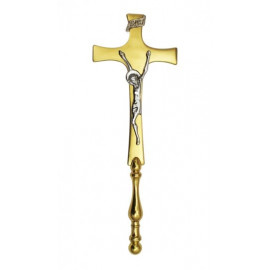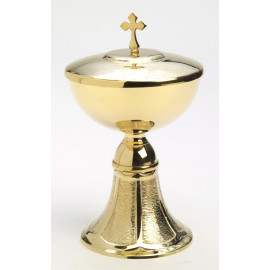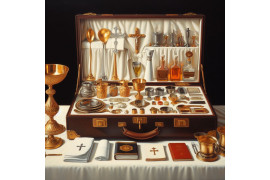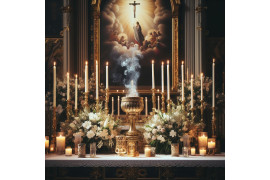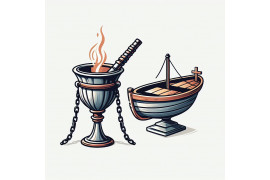Cruets, those small vessels you see on the altar during Mass, play a significant role in the celebration of the Eucharist. These vessels hold two essential substances: wine and water. The presence of these elements symbolizes their importance in the sacrament.
The use of cruets during Mass serves a deeper purpose beyond mere practicality. It highlights the reverence and sacredness of liturgical worship. By carefully pouring wine into the chalice and adding a few drops of water, the priest reenacts Christ's act at the Last Supper, where he consecrated bread and wine as his body and blood.
Understanding what is contained in the cruets at Mass helps us appreciate the rich symbolism behind this ritual. The careful preparation and handling of these vessels remind us of the solemnity and significance of receiving Holy Communion.
Typical Contents Found in Mass Cruets: Wine and Water
Mass cruets, those small containers used during the celebration of Mass, hold significant elements that play a crucial role in the liturgical worship. These vessels typically contain wine and water, each serving its own symbolic purpose.
Wine: Representing the Blood of Christ
One of the main contents found in mass cruets is wine. The wine represents the blood of Christ, which holds great significance within the Catholic faith. During the Eucharistic celebration, when the priest consecrates the bread and wine, it is believed that they transform into the body and blood of Jesus Christ. By using wine in this sacrament, Catholics commemorate Jesus' sacrifice on the cross and his ultimate act of love for humanity.
The presence of wine in mass cruets signifies both remembrance and participation in this sacred moment. It serves as a reminder of Christ's sacrifice and invites believers to partake in communion with him.
Water: Symbolizing Purification and Unity with Christ
In addition to wine, water is also an essential component found in mass cruets. The water symbolizes purification and unity with Christ. Before consecration takes place during Mass, a few drops of water are added to the wine by the priest. This act represents Jesus' humanity being united with his divinity.
Water has long been associated with cleansing rituals across various cultures and religions. In Christianity, it signifies purification from sin and spiritual renewal. By incorporating water into the Eucharistic rite through mass cruets, Catholics acknowledge their need for cleansing from sin and their desire to be united with Christ.
Essential Elements for Celebrating the Eucharist
Both wine and water contained within mass cruets are vital for celebrating the Eucharist—the central sacrament of Catholic worship. The consecrated bread (representing Christ's body) along with his blood (represented by wine) are shared among congregants during Holy Communion. This act is believed to bring believers closer to God and strengthen their spiritual bond with Christ.
The use of mass cruets, holding wine and water, ensures that the necessary elements are readily available for the celebration of the Eucharist. These vessels are typically covered with a white cloth called a purificator, signifying reverence and respect for the sacred contents they hold.
Understanding the Role of Wine in the Eucharistic Celebration
The use of wine in the Eucharistic celebration holds great significance, as it represents Jesus' bloodshed for humanity's salvation. This powerful symbol signifies his ultimate sacrifice and love for all believers. When partaking in communion, the act of drinking wine connects worshipers to Jesus' redemptive act.
Wine: A Representation of Jesus' Blood
In the Eucharistic celebration, wine is used to represent the blood of Jesus Christ. Just as bread symbolizes his body, wine serves as a powerful reminder of his sacrificial death on the cross. This symbolism is deeply rooted in Christian tradition and serves as a poignant reminder of God's love and grace.
Signifying Sacrifice and Love
Wine represents Jesus' blood and signifies his selfless sacrifice and unconditional love for all believers. Through this act, Christians are reminded of the immense price paid for their redemption. The use of wine during communion helps individuals reflect on their own lives and encourages them to emulate Christ's love towards others.
Connecting Believers to Jesus' Redemptive Act
Partaking in the Eucharist with wine creates a tangible connection between worshipers and Jesus' redemptive act. As they drink from the cup, they are reminded that through faith in Christ, they have been cleansed from their sins and have received eternal life. This intimate moment allows individuals to personally experience God's forgiveness and grace.
Deepening Spiritual Experience
The inclusion of wine in the Eucharistic celebration enhances the spiritual experience for believers. It serves as a physical representation of divine grace and mercy, allowing individuals to tangibly connect with God's presence during this sacred ritual. The act of drinking wine becomes a solemn moment where worshippers can express gratitude for salvation and seek spiritual renewal.
Encouraging Unity among Believers
The shared experience of drinking from the same cup of wine during communion fosters a sense of unity among believers. It symbolizes their common faith and shared commitment to follow Jesus Christ. This act of communal participation reinforces the idea that all believers are part of one body, united by their belief in Christ's redemptive work.
Importance of Water in the Preparation of the Eucharist
Water plays a significant role in the preparation of the Eucharist during Mass. It is added to wine, symbolizing our participation in Christ's baptismal grace. This act holds deep meaning and reflects our union with Christ through baptism.
Signifying Baptismal Grace
The addition of water to wine during Mass serves as a powerful symbol of our connection to Christ's baptismal grace. Just as water is used in the sacrament of baptism to cleanse and purify, so too does it represent purification and renewal before partaking in communion. This act reminds us of the spiritual cleansing we undergo when we are baptized into the faith.
Purification, Cleansing, and Renewal
Water has long been associated with purification, cleansing, and renewal across various religious traditions. In Christianity, it holds particular significance as a symbol of spiritual rebirth and transformation. By incorporating water into the Eucharistic celebration, we are reminded of our need for purification and renewal as we prepare ourselves to receive the body and blood of Christ.
Union with Christ Through Baptism
The combination of water with wine represents our individual purification and signifies our union with Christ through baptism. Just as wine is transformed into the blood of Christ during Mass, so too are we transformed through our participation in this sacrament. The mingling of water and wine serves as a reminder that through baptism, we become partakers in Christ's redemptive sacrifice.
Embracing Our Christian Identity
Incorporating water into the preparation of the Eucharist allows us to embrace our Christian identity fully. It reminds us that just as Jesus was baptized by John the Baptist in the Jordan River, so too are we called to embrace our own baptismal promises and live out our faith authentically. The presence of water on the altar during Mass serves as a visual reminder of our commitment to follow Christ and live according to His teachings.
Proper Handling and Preparation of Cruets during the Liturgy
Careful handling is crucial. These small vessels, usually made of glass or metal, hold the sacred elements used in the liturgy. It is essential to ensure that no spillage or contamination occurs while handling these vessels, as they play a significant role in the reverence and sanctity of the sacred liturgy.
Proper cleaning and maintenance are vital for maintaining the sanctity of cruets for future celebrations. After each use, they should be thoroughly cleaned with warm water and mild soap to remove any residue. This practice ensures that there is no leftover wine or water that could spoil or contaminate the next celebration. Regular inspection for cracks or damage is necessary to prevent any potential accidents during mass.
Attention to detail when refilling or pouring from cruets enhances reverence during liturgical worship. The person responsible for handling them should do so with utmost care and respect. Here are some key points regarding their preparation:
Careful Refilling:
-
Before refilling the cruets, make sure they are clean and dry.
-
Pour wine into one cruet and water into another, ensuring accuracy in measurements.
-
Avoid overfilling to prevent spillage.
Pouring from Cruets:
-
Hold one cruet securely with one hand while pouring with the other.
-
Slowly pour wine into the chalice without splashing or spilling.
-
Similarly, pour water into a smaller vessel called a ciborium if required.
Returning Unused Elements:
-
Any remaining consecrated wine from the chalice should be consumed reverently after communion.
-
If there is excess unconsecrated wine in a cruet, it can be poured back into its original container for later use.
-
Water from washing hands may also be poured back into its designated basin.
These practices ensure proper handling and contribute to the overall atmosphere of reverence and respect during the liturgy. By paying attention to these details, the sacred elements used in the celebration remain pure and untainted.
It is worth noting that after mass, any remaining consecrated wine should be reverently consumed or returned to the tabernacle. The cruets should be cleaned thoroughly and stored appropriately for future use. This process ensures that they are ready for the next celebration and maintain their sanctity.
Alms Collection: An Integral Part of the Mass
The alms collection is an important practice that takes place during the Mass. It involves gathering monetary offerings from worshippers, which are then used to support charitable works within the community or organizations affiliated with religious institutions.
This act of collecting alms serves multiple purposes. Firstly, it allows believers to demonstrate their generosity and compassion towards those in need. By contributing financially, they show solidarity with their fellow worshippers and express their commitment to helping others.
During the offertory part of the Mass, a collection plate or basket is typically passed around by ushers or members of the church ministry. Worshippers have the opportunity to place their monetary offerings into these containers as a way of participating in this act of giving. In some cases, there may also be an offertory hymn sung during this time to further enhance the spirit of generosity.
The Roman Missal, which is a book containing prayers and instructions for celebrating Mass, provides guidance on how this collection should take place. It specifies that after the gifts of bread and wine have been presented on the altar by the priest, he may invite the faithful to bring forward their monetary offerings as well.
The collected funds are then used for various charitable purposes such as supporting local outreach programs, providing assistance to those in need within the community, or contributing to larger-scale initiatives organized by religious institutions. These initiatives could include building schools or hospitals, funding scholarships for underprivileged students, or offering aid during times of crisis or disaster.
It's worth noting that while monetary contributions are a common form of alms collection during Mass, there may also be opportunities for individuals to donate other items such as food or clothing. This depends on specific practices followed by different churches and communities.
Reverence and Attention to Detail in the Use of Cruets at Mass
In conclusion, the use of cruets during Mass is a practice that reflects reverence and attention to detail in the celebration of the Eucharist. The typical contents found in these vessels are wine and water, each serving a significant purpose in the liturgy. Wine symbolizes the blood of Christ, while water represents purification and preparation. Proper handling and preparation of cruets are essential to ensure the integrity and sanctity of these elements.
To fully appreciate the significance of this ritual, it is crucial for both clergy and congregation members to understand the role of wine in the Eucharistic celebration. This understanding fosters a deep sense of reverence for this sacred act. Likewise, recognizing the importance of water in preparing for communion allows individuals to approach this sacrament with humility and purity.
As we conclude our exploration into this topic, let us remember that attention to detail is not limited to just cruets but extends to every aspect of our faith. By embracing a meticulous approach rooted in reverence, we can enhance our spiritual experience during Mass.
FAQs
What happens if someone accidentally spills wine or water from the cruets?
Accidents can happen during Mass, even with careful handling. If wine or water is accidentally spilled from the cruets, it should be promptly cleaned up using appropriate methods prescribed by church guidelines. The focus should remain on maintaining reverence throughout the service.
Can other liquids be used instead of wine during Mass?
According to Catholic tradition, only wine made from grapes should be used as a representation of Christ's blood during Holy Communion. Using any other liquid would deviate from this longstanding practice.
Are there specific requirements for selecting cruets used at Mass?
While there may not be strict guidelines regarding cruet selection, it is essential to choose vessels that are suitable for holding both wine and water securely without compromising their quality or integrity. It is also advisable to select cruets that are aesthetically pleasing and complement the sacredness of the Eucharistic celebration.
How often should the cruets be cleaned?
The cruets used for Mass should be cleaned regularly to maintain cleanliness and prevent any contamination. The frequency of cleaning may vary depending on local customs and guidelines, but it is generally recommended to clean them after each use or at least once a week.
Can laypeople handle the cruets during Mass?
In some cases, laypeople may assist in handling the cruets during Mass, particularly if they have been trained for such tasks. However, this responsibility primarily falls upon ordained clergy or designated ministers who have received proper training and guidance in liturgical practices.

